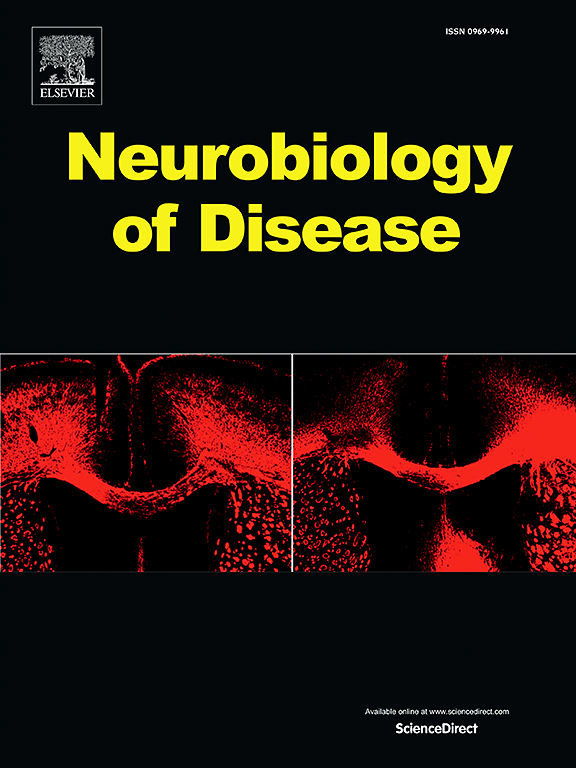在mecp2缺失的Rett综合征小鼠模型中,食欲能信号减弱是睡眠-觉醒问题的基础。
IF 5.1
2区 医学
Q1 NEUROSCIENCES
引用次数: 0
摘要
Rett综合征(RTT)是一种严重的神经发育障碍,主要由编码甲基cpg结合蛋白2 (MeCP2)的x连锁基因突变引起。先前的研究报道了RTT患者和RTT动物模型中以结构和睡眠-觉醒模式改变为特征的睡眠问题。然而,人们对人类或动物睡眠觉醒问题背后的神经机制知之甚少。在本研究中,mecp2缺失小鼠在光-暗条件下的黑暗时期表现出运动活动下降,但在昼夜节律的光调节方面没有表现出明显的行为缺陷。压电监测表明,mecp2缺失小鼠主要在短时间内睡眠,而在长时间睡眠中花费的时间比野生型小鼠少。脑电图分析显示,mecp2缺失小鼠在黑暗期睡眠时间非常短且频繁,这表明黑暗期清醒和非快速眼动睡眠之间的状态转换频繁。与光照期相比,黑暗期的短睡眠次数更多,这可能表明mecp2缺失的小鼠在典型的活跃期花了更多的时间打盹。MeCP2缺乏影响下丘脑区域几种神经调节基因的表达。具体来说,在mecp2缺失小鼠的几个脑区中,下丘脑分泌素/食欲素受体(Hcrtr) 1和2基因的表达显著降低,并且在体内微透析研究中,这些小鼠表现出下丘脑分泌素/食欲素受体激动剂YNT-185的减弱。这些结果表明,在mecp2缺失的小鼠中,下丘脑分泌素/食欲素系统受到干扰,这可能导致睡眠-觉醒问题,如在活动阶段嗜睡增加。本文章由计算机程序翻译,如有差异,请以英文原文为准。
Attenuated orexinergic signaling underlies sleep–wake problems in a Mecp2-null mouse model of Rett syndrome
Rett syndrome (RTT) is a severe neurodevelopmental disorder mainly caused by mutations in the X-linked gene encoding methyl-CpG–binding protein 2 (MeCP2). Previous studies reported sleep problems characterized by changes in architecture and sleep–wake patterns in both RTT patients and animal models of RTT. However, little is known about the neural mechanisms underlying the sleep–wake problems in humans or animals. In this study, Mecp2-null mice showed decreased locomotor activity during the dark period of light-dark conditions, but behaviorally showed no significant deficits in the photic regulation of circadian rhythms. Piezoelectric monitoring demonstrated that Mecp2-null mice slept mainly in short bouts and spent less time in long sleep bouts than their wild-type littermates. Electroencephalographic analysis revealed that Mecp2-null mice had very short, frequent periods of sleep during the dark period, indicating frequent state transitions between wakefulness and non-REM sleep during the dark period. Greater numbers of short sleep bouts during the dark period than during the light period could indicate that Mecp2-null mice spent more time napping during their typically active period. MeCP2 deficiency affected the expression of several neuromodulator genes in hypothalamic regions. Specifically, the expression of hypocretin/orexin receptor (Hcrtr) 1 and 2 genes were significantly lower in several brain regions of Mecp2-null mice, and these mice exhibited attenuated hypocretin/orexin receptor signaling in in vivo microdialysis studies of hypocretin/orexin receptor agonist YNT-185. These results indicate disturbance of the hypocretin/orexin system in Mecp2-null mice, which might cause sleep–wake problems such as increased somnolence in the active phase.
求助全文
通过发布文献求助,成功后即可免费获取论文全文。
去求助
来源期刊

Neurobiology of Disease
医学-神经科学
CiteScore
11.20
自引率
3.30%
发文量
270
审稿时长
76 days
期刊介绍:
Neurobiology of Disease is a major international journal at the interface between basic and clinical neuroscience. The journal provides a forum for the publication of top quality research papers on: molecular and cellular definitions of disease mechanisms, the neural systems and underpinning behavioral disorders, the genetics of inherited neurological and psychiatric diseases, nervous system aging, and findings relevant to the development of new therapies.
 求助内容:
求助内容: 应助结果提醒方式:
应助结果提醒方式:


